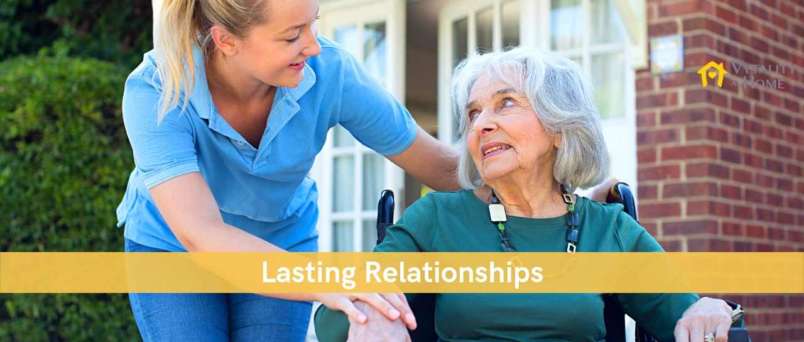Hello again: home care continuity for seniors
Care continuity is very much a hot topic, citing the benefits for patients in hospital and for those in residential care homes who have dementia. However, continuity of care is just as important for those living in their own home.
Inviting in caregivers
When you let caregivers into your home, you invite them into your life, to use your things, to be in your private space, and to help with personal care at a level you probably haven’t even received from close family.
If every time a caregiver arrives it’s someone completely unknown to you, it feels like letting another stranger into your life. This can be unsettling for anyone, but for seniors with particular health needs, it can be a constant source of anxiety. Who will come today? Will they know what to do?
Home care continuity for dementia patients
For those with dementia, lack of care continuity can be deeply unsettling. Whilst their short term memory may not be reliable, their long-term memory covering their lifestyle preferences and personal awareness often remains strong until the disease reaches an advanced stage. Continuity of caregivers provides much-needed stability, reliability and reassurance.
Can you choose your caregiver?
At Vytality at Home, we recognised from the very start the importance of continuity in :
- the people delivering care
and
- the quality and frequency of that care
That’s why we match each client with a specific caregiver we think matches their care requirements, lifestyle, their needs, their personality and even their language preference (as far as possible). As one report says:
“Providing care in the patient’s home affects social interaction and requires a balancing effort between providing care and maintaining the patient’s autonomy, self-determination, and dignity.” (1)
Back by request
Once a caregiver has been to a client’s home for a care session, the client can rate them, and decide if they want that caregiver to return on a regular basis. This is the start of a client/caregiver relationship that can grow and develop over time, The caregiver gets to know the client’s needs beyond their care program, and of course their preferences, whether it’s for coffee rather than tea, or for shaving and washing in a particular way.
Caregivers can also get to know the client’s home preferences; a chair in a certain position to catch the winter sunlight, a kitchen clean on one day and washing the next. They also learn about the client’s preference for in-home activities; cards or chess, crosswords or brain games, gossip or political discussions!
Most importantly, caregivers get to know the person; the doting mother, the proud grandfather, what their kids and grandkids do, and who they rely on for help (or not). They get to enjoy family stories, discover their pasts and their adventures – and our caregivers love that!
Two hours, not twenty minutes
Care is not a service you can dash in, deliver, and dash out again (at least, not in our books). That’s why we operate with a two hour minimum care service time slot. This gives our caregivers time to do necessary personal care, make a drink, do a little cleaning, and still have time to sit and chat too. What’s more, that longer time period allows our caregivers to really get to know clients better, so stories can be told in full, photos admired, without needing to ‘watch the clock’ closely.
“Providing care in the patient’s home also creates a sense of intimacy, and nurses invest in emotional labor and act with sentiment despite a lack of financial compensation.” (2)
Our caregivers become like friends and allies, able to help clients beyond just personal care, perhaps cooking a meal or preparing tea for visitors. They know the best china that’s for visitors, and where it is kept (and that it does NOT go in the dishwasher!). They also know where important items are kept, such as spare glasses, medicines or the TV remote. They know to place objects back where they found them, reducing their physical impact on the home by making life familiar and easier for their clients.
Frequency of care
The more often the same caregiver comes to visit, the more they get to know the client’s physical and mental health. They are in a unique position to be able to monitor their client’s wellness, both physical and mental. If they notice a decline, or a new health issue, they can flag it with us here in the office. We can then inform the family or talk to the client about making an appointment to see their physician (and helping them get to the appointment too).
Continuity of care outside the home
Continuity of care within any healthcare system is a goal many strive for, but not so many systems genuinely achieve. In an article, Relias estimate that:
“The typical person over the age of 65 has seen an average of 28.4 doctors over the course of their lifetime, including primary care providers, specialists, hospital and urgent care providers… The key to improving continuity of care is to begin building caregiving relationships as early as possible.”
We couldn’t agree more. For details of our home care services, or to book a free in-home assessment for yourself or a loved one, call us anytime at 403 476 3680. We look forward to meeting you!
NOTES
(1) Patients’ experiences of homecare nursing: balancing the duality between obtaining care and to maintain dignity and self-determination.
Holmberg M, Valmari G, Lundgren SM
Scand J Caring Sci. 2012 Dec; 26(4):705-12.
(2) Johnson E. K. (2015). The business of care: The moral labour of care workers. Sociology of Health & Illness, 37, 112–126. doi:10.1111/1467-9566.12184




